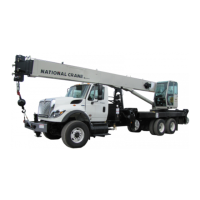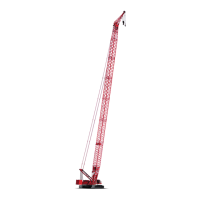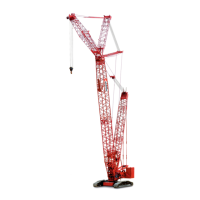Manitowoc Published 09-05-14, Control # 226-02 1-27
14000 SERVICE MANUAL INTRODUCTION
TRAVEL (CRAWLERS) SYSTEM
See Figures 1-15 and 1-16.
Each travel hydraulic pump drives a crawler system motor
and gearbox. Each pump and motor is controlled with travel
control handle movement and node controllers. Travel
control handles are inoperable when travel brake is applied.
The gearbox for each crawler is driven by a flexible shaft
connected to the motor output.
Left travel pump is dedicated to operate drum 3 through a
diverting valve if drum 3 operation is selected. Only one
system can be operated at a time. See Drum 3 (Auxiliary/
Luffing Jib) topic in this section.
To ensure that crane travels in a straight line forward or
reverse direction, each travel drive system has shuttle valves
and pressure senders in each leg that monitor hydraulic
pressure. When traveling, node 4 controller monitors
pressure information from pressure senders and adjusts
displacement of travel pumps to maintain equal pressure in
each travel drive system.
Continuous changing of closed-loop fluid occurs through
leakage in pump, motor, and loop flushing valves that
removes 5 g/m (19 L/m) of fluid to when system pressure is
above 200 psi (14 bar).
The travel pumps output can be programmed for 25% to
100% of rated volume on Function Mode screen (see
Section 3 of this manual).
When either travel control handle is moved from off, an input
signal is sent to node 1 controller. Node 4 controller sends a
24 volt signal to enable right side and left side swing/travel
alarm. When both travel control handles are moved to off, an
input signal is sent to node 1 controller. Node 3 controller
sends a zero volt output signal to disable right side and left
side swing/travel alarm.
Travel Brakes
Hydraulic pressure for releasing travel brakes is from drum
3/left travel charge pump at approximately 350 psi (24 bar).
For travel brake operation system pressure must be above
200 psi (14 bar) for travel brakes to fully release from each
travel motor shaft. If system pressure is below 200 psi (14
bar), travel brake could be partially applied and damage the
brake. If brake pressure or electrical power is lost when
operating, the travel brakes apply.
When travel brake switch is in on - park position, right and
left travel brakes are applied to hold crane in position. Travel
brake valve opens to allow hydraulic flow from brake to tank.
When travel brake switch is in off - park position, an input
signal is sent to node 1 controller. Travel system circuit is
enabled, waiting for a travel control handle command. When
travel control handle is moved an input signal is sent to
node 1 controller. Node 3 controller sends a 24 volt output to
enable travel brake release solenoid HS-15. Brake valve
shifts to block tank port and supplies low pressure hydraulic
fluid from drum 3/left travel charge pump at approximately
350 psi (24 bar) to release crawler brakes. If brake pressure
or electrical power is lost when operating, brakes apply.
Travel Motors
Travel motors are variable displacement and shift internally
with an adjustable spring in each motor P/C (Pressure/
Compensator) valve, preset at approximately 3,915 psi (270
bar). Travel motors are in minimum displacement (low
torque, high-speed) position when starting. When crawler
begins to move, a high system pressure shifts the ECOR
(Electric Compensated Over-Ride) spool placing travel
motor in maximum displacement (high torque, low speed)
position for breakaway torque.
Travel Forward
When a travel control handle is moved in forward direction,
an input voltage of 2.6 or more volts is sent to node 1
controller. Node 3 controller checks that drum 3/left travel
diverting solenoid valve HS-10 is disabled (open to left travel
motor) and closed to drum 3 motor (normal condition).
Node 4 controller sends a variable 0 to 24 volt output that is
divided by resistors and applied to selected travel pump
EDC. Node 3 controller sends a 24 volt output to enable
travel brake release solenoid HS-15 and release selected
crawler brake, before travel pump(s) strokes.
Travel pump EDC tilts selected pump swashplate in forward
direction. Hydraulic fluid flow is from left travel pump outlet B
and right travel pump outlet A, through diverter valve (left
travel flow only), through swivel to left travel motor inlet port
and right travel motor inlet port. Return fluid is from motor
outlet ports to pump inlet ports.
Node 4 controller input voltage to travel pumps EDC is
relative to control handle movement. As selected travel
control handle is moved to neutral position, node 1 controller
compensates for hydraulic system leakage or changing
engine speed. Node 4 controller sends a zero output voltage
to pump EDC to move swashplate to center position.
After travel control handle command is off for a preset time,
node 3 controller sends a zero output voltage to disable
travel brake solenoid HS-15. Travel brake valve shifts to
block pilot pressure to brakes and opens a line to tank.
Brakes apply.
Travel in Reverse
When a travel control handle is moved in reverse direction,
an input voltage of 2.4 volts or less is sent to node 1
controller. Node 3 controller checks that drum 3/left travel
diverting solenoid valve HS-10 is disabled (open to left travel
motor) and closed to drum 3 motor (normal condition).

